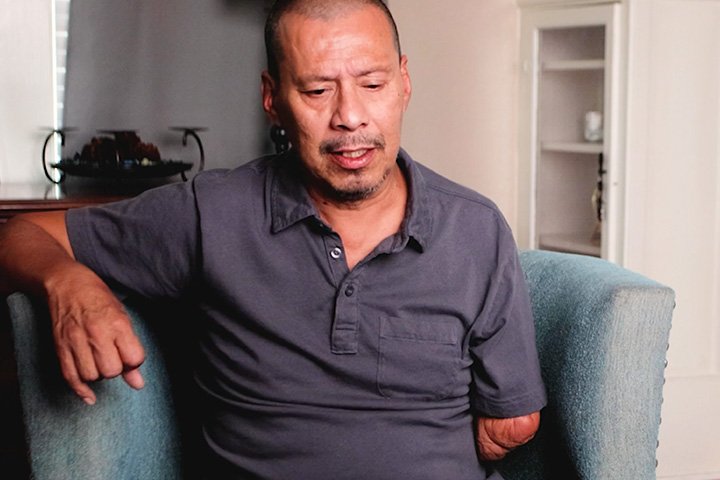The value in this case report, once you have read this brief summary of the facts, is studying a powerful settlement conference video, linked below. It masterfully combines proof of liability with a day-in-the-life suffering of an amputee.
A fifty-five-year-old bicyclist eastbound in lane three on Story Road approaching U.S. 101 collided into the side of a VTA bus. There was no bicycle lane. The cyclist drove on the right side of lane three.

In the collision, the bus’s rear wheels crushed the cyclist’s arm, tearing his forearm muscles from the radius and ulna. A microvascular reconstructive surgical team could not save his arm in multiple procedures. Amputation and skin grafting followed.
On admission to the Emergency Department at Regional Hospital, our client’s blood showed a blood alcohol concentration of 0.25, three times the 0.08 limit for a car driver. The cyclist had been riding an electric bike, legally classified as a bicycle under Vehicle Code Section 231. Although the Cycling-Under-the-Influence statute, Vehicle Code 21200.5, does not explicitly define a BAC level for cyclists, at this level, it did not matter. The 0.25 would be coming into evidence.
Over several miles, onboard closed-circuit cameras recorded the bus driver’s views through the windshield and alongside the bus through the front door and rearward. Those videos are incorporated into the settlement conference statement that is linked below.
At all times, our client was riding in a straight line without swerving on his way home after work. The top speed on the electric bike was 20 mph. He came to a complete stop at red lights and kept his bicycle to the far right of lane three. Vehicle Code Section Code §21202.
As the bus passed him, the cyclist was trapped by “leading edge turbulence” caused by the flat surface of the bus as it “plowed” through the air, creating clockwise vortices at the front corners of the bus.
As the bus passed on the left of the bicyclist, the front edge of the vortex pushed the cyclist away. The rider corrected turning left. As the bus and its vortex passed, the airflow pulled the bicyclist into the side of the bus. The cyclist crashed to the pavement, and the rear wheels captured his arm. That CCTV footage is the settlement conference statement, linked below.
You will not find leading-edge entrapment in fluid dynamics literature, but it is a true phenomenon. Thank you to Las Vegas attorney Will Kemp, Dr. Robert Breidenthal, University of Washington Department of Aeronautics, and Brian Sherlock, Executive Board of the Amalgamated Transit Union, Washington, D.C., for sharing their knowledge of bus turbulence entrapment of bicyclists.
Body camera videos of the San Jose officers discussing their investigation noted that the bicyclist had the right of away, which was, in fact, the case. The bicycle “owned” the lane of travel. As required by law and VTA policies, the bus traveling at 32 mph should have overtaken the bike safely and moved into lane two to pass. Although the officers’ opinions would be inadmissible at trial, for a settlement presentation, their matter-of-fact conclusions would gain the attention of the VTA’s claims manager.
Thank you to Louis Cheng, Ph.D., our biomechanical engineer, who painstakingly re-created the crash sequence by combining the VTA video and scans of the roadway, which had been re-striped. That was no easy task. Cheng’s analysis confirmed the driver failed to yield to the cyclist and passed the bicyclist within 3 feet. At the time, lane two, to the left, was open and provided substantial room for a lane change to avoid the cyclist. VTA did not dispute that the bus driver came within three feet of the bicycle.
Dr. Cheng presented his detailed reconstruction at the mediation with Judge Jamie Jacobs-May, JAMS, San Jose. Dr. Rajeev Kelkar offered his reconstruction on behalf of the VTA and its defense that the cyclist should have been able to keep his bicycle under control as the bus passed.
Alex Barchuk, M.D., a physical and rehabilitation medicine specialist, prepared our lifecare plan.
Kudos to Nina Shapirshteyn.
In deposition, Nina obtained solid admissions from the defendant bus driver. She produced a superb settlement conference video. It captured the essence of a kind and gentle man through his mother and hair salon co-workers, correlated her interview of a passenger on the bus with a video of the interior of the bus at the time of impact, and included the police officer’s body camera footage, police interview of our client in the hospital, pre-surgery photos of our client’s emasculated arm, the bus driver’s deposition testimony and bus video of the driver’s views through the windshield, side door and rear mirror into a final presentation of liability and damages for mediation.
The settlement conference video was delivered to the VTA ten days before mediation to allow for a full review by VTA’s claims committee.
Paiz v. Santa Clara Valley Transportation Authority, Santa Clara County Superior Court, 19CV348819. Defended by Richard North, Esq.
Contact Our San Jose, CA Personal Injury Lawyers For Immediate Help
Alexander Law Group, LLP attorneys are available to answer questions and share our knowledge of the law and the results of our research and experience. Our goal as personal injury lawyers is to make a difference for our clients. Every day we deal with a range of health and safety issues that most people do not encounter until after an injury occurs. As safety lawyers we are committed to providing our clients and the public with information for safer and healthier living. Call 888-777-1776 or contact us online to schedule a consultation to see how we can help you.


